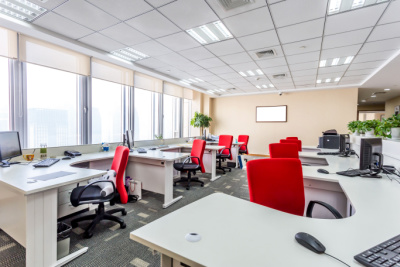Back to Basics is an article series that highlights important, but possibly overlooked, information facilities management professionals should know.

A key aspect of a healthy facility is healthy lighting, not just to go green for the environment but also for the health of occupants. Facilities managers should therefore examine ways they can redesign their facilities so both workers and customers can enjoy a place that encourages good psychological, emotional, and physical health.
Having a healthy workforce and customer base, as well as going green and saving some green, is highly beneficial for everyone.
Improving Interior Artificial Lighting
It’s important for employees and customers to have adequate lighting for good visibility but not too much lighting, as it can have a negative impact on their health.
Facilities managers should consider replacing traditional lights with light-emitting diode (LED) lighting, especially because the federal government has banned retailers from selling incandescent lightbulbs as of August 1, 2023. Also, consider replacing not only modular lighting in the ceiling but also task lighting at desks.
While there is an initial cost to replace old incandescent and fluorescent lighting with LED, it’s likely to pay off in the long haul. According to ENERGY STAR, LED lighting can provide the same brightness as traditional bulbs but lasts 15 times longer, which helps save on the costs of operation and maintenance.
While LED lights release little heat, incandescent bulbs release 90% of their energy as heat, and compact fluorescent lamp (CFL) bulbs release 80% of their energy as heat.
Specifically, facilities managers whose buildings are in regions with high electricity costs and have long operating hours will see the greatest return on their environmentally friendly investment.
ENERGY STAR reports that many energy efficiency programs that target specific commercial buildings, like rebates and buy-downs, can result in up to $249 in savings for LED light fixtures.
Truly healthy buildings will embrace not just artificial lighting but also ways of bringing natural light into their facilities.
Improving Natural Light
While it might be obvious, increasing natural sunlight in a facility can lead to better overall health and sleep quality for employees, as observed in a study reported by the National Library of Medicine. This can ultimately lead to better productivity.
Additionally, effectively using natural sunlight can help reduce artificial lighting, cutting the company’s bottom line. Facilities managers should use this natural light to eliminate over-lit or under-lit areas of the facility.
Care should be taken to ensure furniture and computers don’t block light from the windows, and position computers to eliminate glare.
Furthermore, consider the following suggestions:
- Install vertical blinds for east and west windows and horizontal blinds for north and south windows.
- Clean the inside and outside of all windows.
- Cut back on landscaping near the windows to increase sunlight.
- See if there are any windows that have been painted or walled off, and if so, open them back up.
- Think about replacing roof panels with skylights, especially in areas without windows.
Keep in mind that south-facing windows provide winter sunlight but little direct sun during summer, while north-facing windows provide even and natural light, with little glare and no unwanted summer heat gain, according to the Department of Energy (DOE). However, east- and west-facing windows provide great daylight in the morning and evening but could cause glare and bring in heat during the summer.
Additionally, facilities managers should consider bringing artificial lighting to exterior portions of the property.
Upgrading Exterior Lighting
To increase security, as well as occupants’ mental and emotional health, ensure the facility has adequate exterior lighting so workers feel safe if they work past sunset or during cloudy, foggy, rainy, or snowy conditions.
Exterior lighting should also serve the needs of drivers, bicyclists, and pedestrians.
Based on the size and characteristics of your facility, consider the following:
- Pole-mounted lighting: While this is most effective for large parking lots, ensure this provides adequate lighting in all areas. If not, increase the light wattage or add more lights if needed.
- Landscape lighting: This lighting is effective at eliminating dark corners or areas of the facility’s exterior. Consider one or more of the most popular types of outdoor lighting, including floodlights, spotlights, wall lights, ceiling lights, bollards, and lamp posts.
- Parking garage lighting: This is necessary for all facilities with parking garages. Consider ways to increase and improve lighting for both pedestrians and drivers, which could include bringing more natural light in with windows in stairwells and elevator lobbies, as well as adding artificial lighting to dark corners.
Furthermore, consider replacing high-intensity (HID) lamps in parking lot lights with LED lighting.
Learn more about exterior lighting by checking out a report called “Exterior Lighting Control Guidance” on the DOE website.
Creating a Healthier Building
A truly healthy building will have just the right amount of interior artificial lighting, natural light to shine into facility interiors, and exterior lighting, which is necessary at night and during inclement weather.
By upgrading their lighting, facilities managers will encourage a healthier workforce and customer base, resulting in a healthier pocketbook from using less energy with LED lighting.
Check out the Facilities Management Advisor’s Healthy Buildings Week 2023 Event Week Schedule by clicking here.
